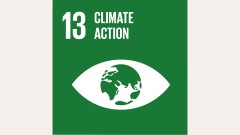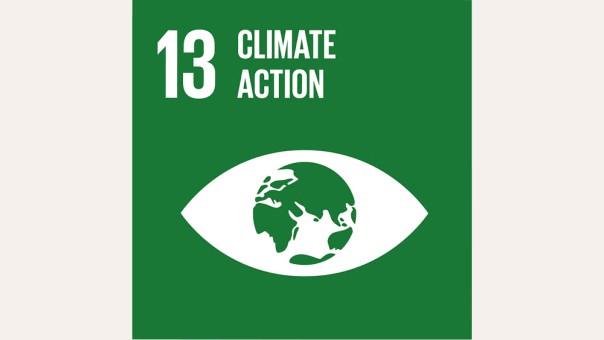Morocco is harnessing the potential to free itself from fossil fuels with concentrated solar power plants. This is exemplary from an emerging country, and a bold step that is supported by international donors like KfW..
It is still early morning, but the sun already sits high in the sky. The wind blows over the red surface that stretches to the Atlas Mountains in the distance. Here in the arid and hot stony desert, not far from the southern Moroccan city of Ouarzazate, one of the largest solar energy complexes in the world has been built on an area of 3,000 hectares. It is called Light – Noor in Arabic – and comprises four large-scale projects.
Solar complex Ouarzazate - Electricity from the desert
Source: KfW / Thomas Schuch
The first, NOORo I (the small "o" stands for Ouarzazate) with a capacity of 160 megawatts has been in operation since spring 2016. It already produces 400 GWh of power a year, which corresponds to the average consumption of around 400,000 people in Morocco. To this end, more than half a million parabolic mirrors track the sun, swivelling every few minutes to adjust their angle to the sun as the earth rotates.
The total surface of the mirrors amounts to 1.4 million square metres, or just under 200 football pitches. They were provided by Nuremberg company Flabeg, and accurately train the light energy on an "absorber tube" two metres away, which circulates synthetic oil that is heated to 400 degrees Celsius. At the edge of the mirror farm, a turbine generates electricity via water vapour from the hot oil. The turbine was made by Siemens and Lahmeyer engineers acted as technical consultants for the project.

Tiara of the desert
The aerial photo from early summer in 2017 shows the increasing number of mirrors installed around the tower of NOORo III.
German companies that were successful in the international competition are helping to realise the country's objectives. By 2030, the share in electricity production capacities based on renewable energies is due to rise from the current 34 per cent to 52 per cent. There is barely any other emerging economy that has adopted such a similarly bold position. Morocco also plays a pioneering role on a global scale. The country's carbon emissions are in line with the goal of the Paris Agenda to limit global warming to 1.5 degrees Celsius maximum.
There is no other country which achieves this, and this is anything but self-evident: when Morocco decided to push forward with its green energy transition a few years ago, there were other options on the table – continuing to focus on fossil fuels, for example, to satisfy the country's growing energy requirements, in view of the massive slump in the price of crude oil.
"The fact that Morocco plumped for a green and sustainable future shows forward, long-term planning", said Markus Faschina, then Head of the KfW regional office in Morocco. "In this context, Morocco is banking on forward-facing technologies because no other country had built such a large solar complex with different technologies in one location."
The government's decision to deploy not just wind energy and photovoltaic installations but also solar thermal power plants with energy stores was not necessarily an obvious one. But Morocco created a precedent. "It is brave to act in good time and not wait for others to show you the way first," added Faschina. This means opportunities can also be seized because the very promising project in Ouarzazate to build the world's largest solar power plant complex with a total capacity of 580 megawatts convinced international donors.

AFD
The Agence Française de Développement (AFD) is the French development bank and an important partner of KfW in Financial Cooperation. By 2019 more than 100 joint projects had already been implemented. Both banks belong to the IDFC network of development banks.
The Federal Ministry for Economic Cooperation and Development (BMZ) as well as the Federal Ministry for the Environment (BMUV) contributed roughly 830 million euros to the total investment of 2 billion euros, with the help of KfW Development Bank. The remainder was covered mainly by public-sector donors and development banks like the French Agence Française de Développement (AFD). The European Union subsidised the Neighbourhood Investment Facility.
The decision paid off: "The initial operating experiences are positive, and production is meeting expectations," said Faschina. Alongside the skilled personnel and the reliable technology, this is due to one thing: the availability of solar energy. "Here in the desert is where the level of solar irradiation is at its highest on our planet," he revealed. At around 2,500 kilowatts per square metre and year, the sun delivers twice as much energy as in Germany. This makes an investment in solar energy profitable.
Flagship project
NOORo III is the third part of the solar power complex in Morocco. An ocean of mirrors, mounted on concrete pylons, surrounds the solar tower.

Sun worshipper
More than half a million parabolic mirrors track the sun. These are swivelling every few minutes to adjust their angle to the sun.
Up until recently, Morocco had to import 90 per cent of the fossil fuel that its energy system was based on. This seems sustainable for the economy as long as oil prices remain low. Yet if this changes in a few years, as is generally assumed, and there is no switch made to local green energy, import costs could rocket.
For the time being, Morocco has to cover its own demand. In the long run though there is the option to supply favourably priced green electricity to Europe as well, thereby generating export revenue from environmentally-friendly power. And, in future, the country can put its experience regarding solar thermal power plants and switching to renewable energies at the disposal of other countries.

Hot-cold
The sun heats salt in the tower to 560 degrees Celsius to drive the turbines with water vapour. Ventilators cool the vapour back down for the cycle to begin again.
Last but not least, the climate benefits: "Every year NOORo I avoids emissions of at least 230,000 tonnes of CO₂," estimates Faschina. All of the Ouarzazate solar power plants collectively save roughly 800,000 tonnes each year. And that is not all.
"In contrast to photovoltaic installations, solar thermal power plants also offer the chance to supply electricity at night," said Tarik Bourquouquou. An engineer at Masen, the Moroccan agency responsible for renewable energies, he was in charge of infrastructure and planning for the solar energy complex.
Two large tanks not far from the turbine building hold 45,000 tonnes of liquid salt. This mixture containing sodium and potassium nitrate from BASF stores the energy produced during the day that is not used immediately for generating electricity, and delivers it in the evening hours to produce power.


NOORo III
At 242 metres it is on of the the highest structure in Africa.
"Our new solar power plants are able to do even more," said Bourquouquou. One great example of this is the solar tower, yet another superlative here in the stony desert and situated not far from the sea of parabolic mirrors. We need a car to get there, past the three other power plants. They all started operation in 2018.
The car stops in front of a huge tower. At 242 metres it is on of the the highest structure in Africa. Around it there are 7,400 concrete pylons, on which large mirrors – heliostats– each 180 square metres in size are mounted. They reflect the sunlight to the top of the tower.
This technology creates even higher temperatures than other solar power plants do. The salt that circulates at the top of the tower reaches more than 560 degrees Celsius. "The plant is able to generate power for seven hours after the sun has gone down," says Tarik Bourquouquou, full of pride, "more than any solar power plant ever before."
The country also leads the way with sensitive issues such as water consumption. While the first power plant has a classic cooling tower that cools the water vapour once it exits the turbine, and therefore still needs water, the two plants, NOORo II and III, are equally ground-breaking in the world with their dry-cooling systems.
Published on KfW Stories on 3 May 2017, last updated on 29 September 2023.
The described project contributes to the following United Nationsʼ Sustainable Development Goals
Goal 7: Ensure access to affordable, reliable, sustainable and modern energy
Close to 80 per cent of the energy produced worldwide still comes from fossil fuel sources. Burning fossil fuels also generates costs for the health system due to air pollution and costs for climate-related damages that harm the general public, not just those burning the fuel.

All United Nations member states adopted the 2030 Agenda in 2015. At its heart is a list of 17 goals for sustainable development, known as the Sustainable Development Goals (SDGs). Our world should become a place where people are able to live in peace with each other in ways that are ecologically compatible, socially just, and economically effective.


























Data protection principles
If you click on one of the following icons, your data will be sent to the corresponding social network.
Privacy information